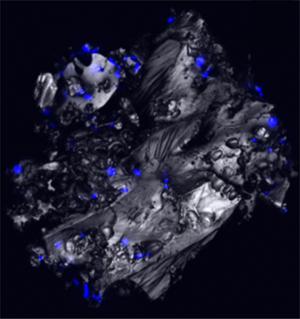Technology Profile

Bacteria (blue) attached to a biochar particle (grey). (Image courtesy of Tim Mattes)
Researchers at the University of Iowa are investigating how biochar, the carbon-rich byproduct of burning plant matter, can enhance the performance of a type of bacteria — called organohalide-respiring bacteria (OHRB) — commonly used to break down halogenated pollutants. Chlorinated ethenes, a type of halogenated pollutants, are among the most frequently detected contaminants in aquatic ecosystems across the U.S.
OHRB is not able to fully degrade halogenated pollutants in the field. To address this limitation, the team is developing a platform to tailor the properties of biochar to increase the ability of OHRB to break down chlorinated ethenes into non-toxic substances.
| Technology | Adding biochar to contaminated sites can boost the ability of OHRB to interact with the surrounding microbial community to break the carbon and chlorine bonds that make up halogenated compounds, converting them into non-toxic substances. The team’s biochar is produced by burning poplar tree biomass at high temperatures, up to 900°C, in oxygen-free conditions. Poplar trees are useful in a variety of environmental applications, including remediation, because they grow quickly and produce a large amount of biomass — branches, foliage, stem, and bark — over relatively short rotations. |
|---|---|
| Innovation | Existing technologies that use carbon-based materials, like biochar, can attract and bind organic pollutants like chlorinated ethenes, but not destroy them. The researchers conducted studies to understand what properties confer biochar its reactivity. Informed by this data, they are developing a tunable platform where surface charge and characteristics that control the transfer of electrons, known as redox potential, can be varied individually. They are also testing different burn conditions to optimize the biochar’s surface properties, such as pore size. The properties of the improved biochar can stimulate the growth of bacteria that interact to break carbon and fluorine bonds, including Dehalococcoides — a type of OHRB commonly used in remediation efforts — and bacteria that produce lactic acid during fermentation. The poplar biochar also stimulates metabolic reactions that help OHRB achieve complete degradation of chlorinated ethenes in the environment. |
| Contaminant and Media | Chlorinated ethenes in groundwater, soil, and sediment. |
| Technology Readiness Level | TRL 2 - Technology concept formulated |
| Principal Investigator | Timothy E. Mattes |
| Institution | University of Iowa SRP Center |
| Grant Number | R01ES032671 |
to Top



